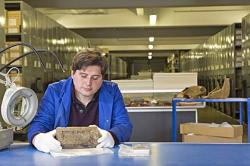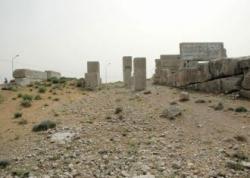INSTITUT SUPERIEUR D'ANTHROPOLOGIE
INSTITUTE OF ANTHROPOLOGY
ONLINE COURSES / COURS A DISTANCE
INSCRIPTION 2012 / Session III : Juillet 2012
REGISTRATION 2012 / Term III : July 2012
ROYAUME UNI –  Ilkley - West Yorkshire Archaeology Advisory Service (WYAAS) is asking Bradford Council to defer its decision on plans for a link building between the historic All Saints Parish Church and nearby Church House. The proposed development is situated within the remains of Olicana Roman Fort, say archaeologists, which is thought to have been built by Agricola in AD70 to 80. Excavations of the site last century concentrated on the northern section of the fort, but it is believed the ancient Roman headquarters, or “principia”, of the fort is in the southern part of the site, in the church and graveyard area. WYAAS, the district’s official professional advisor on the historic environment, believes excavation also has the potential to uncover Anglo-Saxon, medieval and post-medieval remains.
Ilkley - West Yorkshire Archaeology Advisory Service (WYAAS) is asking Bradford Council to defer its decision on plans for a link building between the historic All Saints Parish Church and nearby Church House. The proposed development is situated within the remains of Olicana Roman Fort, say archaeologists, which is thought to have been built by Agricola in AD70 to 80. Excavations of the site last century concentrated on the northern section of the fort, but it is believed the ancient Roman headquarters, or “principia”, of the fort is in the southern part of the site, in the church and graveyard area. WYAAS, the district’s official professional advisor on the historic environment, believes excavation also has the potential to uncover Anglo-Saxon, medieval and post-medieval remains.
http://www.ilkleygazette.co.uk/news/9657997.Call_for__delay_on_church_site_plan/
ROYAUME UNI –  Londres - More than five million ancient artefacts lie in the vaults of the Museum of London. Records of 8,500 excavations – some from the early 19th century – take up 10 kilometres of shelving in 120,000 brown boxes full of mystery. So it’s no surprise that the judges of the Guinness World Records have officially declared it the largest archaeological archive in the world.
Londres - More than five million ancient artefacts lie in the vaults of the Museum of London. Records of 8,500 excavations – some from the early 19th century – take up 10 kilometres of shelving in 120,000 brown boxes full of mystery. So it’s no surprise that the judges of the Guinness World Records have officially declared it the largest archaeological archive in the world.
http://www.culture24.org.uk/history%20%26%20heritage/archaeology/art383334
SUEDE –  Kaseberga - Ancient Scandinavians dragged 59 boulders to a seaside cliff near what is now the Swedish fishing village of Kaseberga. They carefully arranged the massive stones — each weighing up to 4,000 pounds (1,800 kilograms) — in the outline of a 220-foot-long (67-meter) ship overlooking the Baltic Sea. Archaeologists generally agree this megalithic structure, known as Ales Stenar ("Ale's Stones"), was assembled about 1,000 years ago, near the end of the Iron Age, as a burial monument. But a team of researchers now argues it's really 2,500 years old, dating from the Scandinavian Bronze Age, and was built as an astronomical calendar with the same underlying geometry as England's Stonehenge.
Kaseberga - Ancient Scandinavians dragged 59 boulders to a seaside cliff near what is now the Swedish fishing village of Kaseberga. They carefully arranged the massive stones — each weighing up to 4,000 pounds (1,800 kilograms) — in the outline of a 220-foot-long (67-meter) ship overlooking the Baltic Sea. Archaeologists generally agree this megalithic structure, known as Ales Stenar ("Ale's Stones"), was assembled about 1,000 years ago, near the end of the Iron Age, as a burial monument. But a team of researchers now argues it's really 2,500 years old, dating from the Scandinavian Bronze Age, and was built as an astronomical calendar with the same underlying geometry as England's Stonehenge.
http://www.foxnews.com/scitech/2012/04/19/swedish-stonehenge-ancient-stone-structure-spurs-debate/
IRAN –  Estakhr / Arasnajan - Archaeological teams from Italy and Japan are scheduled to travel to Iran separately in order to conduct a series of studies on several ancient sites in Fars Province. An Italian team will arrive in the country on April 24. The team will excavate the Sassanid city of Estakhr for 45 days to find probable signs of early mosques that were built after the advent of Islam, he added. The city, which was also inhabited during the Achaemenid period and early Islamic era, is located on the outskirts of the 6000-year-old Mount Rahmat (also known as the Rahmatabad Tepe) near Persepolis in the Marvdasht region. A team composed of Iranian and Italian members led by Professor Pierfrancesco Callieri of the University of Bologna conducted a series of excavations in Estakhr in 2008. Mireskandari said that another Italian team, which will arrive in Iran late May, plans to study the Sassanid city of Bishpur to learn about the waterworks at the site located 23 kilometers north of the town of Kazerun. The Cultural Heritage, Tourism and Handicrafts Organization (CHTHO) has recently applied for registration of the ruins of Bishapur on UNESCO’s World Heritage List. The Japanese group will do research on the ancient sites around the town of Arasnajan. Located 120 kilometers northeast of the city of Shiraz, Arasnajan is surrounded by sites dating back to the Achaemenid, Sassanid, and Timurid eras. Mireskandari said that an Iranian archaeologist will lead each team and a number of Iranian experts will also accompany the groups in their excavations. “These groups will bring the necessary advanced equipment with them and the Iranians will have the opportunity to become acquainted with that equipment during the studies,” he sated.
Estakhr / Arasnajan - Archaeological teams from Italy and Japan are scheduled to travel to Iran separately in order to conduct a series of studies on several ancient sites in Fars Province. An Italian team will arrive in the country on April 24. The team will excavate the Sassanid city of Estakhr for 45 days to find probable signs of early mosques that were built after the advent of Islam, he added. The city, which was also inhabited during the Achaemenid period and early Islamic era, is located on the outskirts of the 6000-year-old Mount Rahmat (also known as the Rahmatabad Tepe) near Persepolis in the Marvdasht region. A team composed of Iranian and Italian members led by Professor Pierfrancesco Callieri of the University of Bologna conducted a series of excavations in Estakhr in 2008. Mireskandari said that another Italian team, which will arrive in Iran late May, plans to study the Sassanid city of Bishpur to learn about the waterworks at the site located 23 kilometers north of the town of Kazerun. The Cultural Heritage, Tourism and Handicrafts Organization (CHTHO) has recently applied for registration of the ruins of Bishapur on UNESCO’s World Heritage List. The Japanese group will do research on the ancient sites around the town of Arasnajan. Located 120 kilometers northeast of the city of Shiraz, Arasnajan is surrounded by sites dating back to the Achaemenid, Sassanid, and Timurid eras. Mireskandari said that an Iranian archaeologist will lead each team and a number of Iranian experts will also accompany the groups in their excavations. “These groups will bring the necessary advanced equipment with them and the Iranians will have the opportunity to become acquainted with that equipment during the studies,” he sated.
http://www.tehrantimes.com/arts-and-culture/97041-italian-japanese-archaeologists-to-study-ancient-sites-in-southern-iran
CHINE - Longshan'gang - An important achievement was made during recent excavations on the Longshan'gang Ancient Site, Xichuan County, Henan Province. Archeologists discovered a dyke ruins which was constructed in the later period of the Yangshao Age (Zhujiatai Culture). It is a very rare one in cultural ruins of the same period in the middle reaches of the Han River. Also called the Huanglianshu Ancient Site, the Longshan'gang Ancient Site is a cultural relic protection project in the inundated area of the Danjiangkou Reservoir in the middle section of the South-to-North Water Diversion Project. Since May 2008, the Institute of Cultural Relics in the Henan Province has been carrying out archaeological surveys and excavations on the site. Up to now, they have excavated 10,900 square meters in total. After doing archaeological surveys and excavations for four successive years, archaeologists have fundamentally made clear the ranges and layout of the cultural relic piles of various periods of the Neolithic Age and made many important achievements. This ancient site has abundant ruins, including ruins of the Qing Dynasty, Ming Dynasty, Song Dynasty, Yuan Dynasty, Han Dynasty, Western Zhou Dynasty, Wangwan Third Stage Culture, Shijiahe Culture, Qujialing Culture and later period of the Yangshao Age (Zhujiatai Culture). Their distribution range is wide. Types of the ruins include the dyke, large-scale multi-room house, ash pit and worshipping area, of which, the dyke ruins discovered this time is most significant. The person in charge of excavating the ancient site said that the dyke ruins is located in the northeastern edge of the Neolithic Age ruins zone and has a south-to-north structure. Newly discovered ruins of the Neolithic Age are all located within the dyke (to the southwest of the dyke). Outside the dyke is an ancient river channel (low land). The southeast end of the dyke is at the turning point of the river channel and the northwestern end of the dyke is at the northwestern part of the ancient site. The dyke was made of tamped mud and is very solid. The archaeological team also found that the internal slope of the dyke is on the remains of a collapsed house, which is preserved quite well. From the ware excavated from the house, it could be judged that the dyke belonged to the later period of the Yangshao Culture (Zhujiatai Culture). The situation that many ruins of the later period of the Yangshao Culture accumulate on the internal slope of the dyke has also confirmed the construction time of the dyke. Experts believe that, from the location and the surrounding tribe environment of the dyke, it could be judged that the function of the dyke was to control the flood. Since its construction structure is similar to those of many city and city wall ruins of the Neolithic Age discovered in the middle reaches of the Yangtze River, the dyke ruins not only has certain significance for studying the functions of the prehistoric city walls in the middle reaches of the Yangtze River but also has high academic values for researching the tribe formation transition and the law of the transition of this place in various periods of the Neolithic Age and for learning about the cultural appearance and nature of the connection region between the southern and north cultures.
http://www.kaogu.cn/en/detail.asp?ProductID=3431